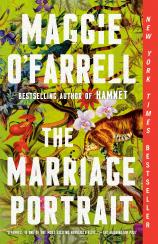The Marriage Portrait
Review
The Marriage Portrait
At one point last year, it seemed like everyone I knew, even those who don’t normally search out historical fiction, was reading Maggie O’Farrell’s Shakespeare-inspired novel, HAMNET. Whether you’re the kind of person who frequently enjoys time-traveling through fiction, or you’ve been holding out for a second trip back in time with O’Farrell, you’re in luck: THE MARRIAGE PORTRAIT is another richly imagined, suspenseful, feminist historical novel.
This time, O’Farrell takes her readers to the late Italian Renaissance, in the 1550s and 1560s, and the subject of a poem that might be familiar to many: Robert Browning’s “My Last Duchess,” which is narrated by Alfonso II, the Duke of Ferrara, in northern Italy. Here, however, O’Farrell flips the script and tells the story of Alfonso’s bride, the one who was portrayed in the portrait at the center of the poem. She was Lucrezia, part of the eminent Medici family of Florence, who died at age 16, only a year after marrying the duke.
"I fully expect that over the next few months, this unforgettable book will be the historical novel that everyone is reading and fervently discussing."
In THE MARRIAGE PORTRAIT, O’Farrell imagines Lucrezia’s childhood in the Florentine court, her love of animals and learning, along with her free spirit. She also recounts the history of Lucrezia’s betrothal at a young age to Alfonso; he previously had been betrothed to her older sister, who died before they could wed. She illustrates the close and loving relationship of Lucrezia to her nursemaid, who ingeniously protected her from marriage for as long as she could.
O’Farrell intersperses these scenes of youth and childhood with later scenes of Lucrezia’s marriage to Alfonso --- from their idyllic honeymoon at a country estate to her eventual presentation at court. Further ramping up the suspense are dread-filled scenes of the couple several months later, at a remote and isolated fortress, where Lucrezia has become convinced that Alfonso intends to kill her because she has not yet produced an heir.
O’Farrell’s storytelling is masterful. Most scenes are told from Lucrezia’s perspective, and they build a complex and nuanced picture not only of this bright and sensitive young woman but also of those who surround her. They include her ladies’ maid, the artist commissioned to paint that titular portrait, her new sisters-in-law, and Alfonso himself, who is portrayed initially as thoughtful and kind but whose cruelties and desperation become increasingly apparent --- and troubling --- as the narrative unfolds.
Lucrezia is written as a girl whose intellect and talents, particularly her skills in languages and art, are underappreciated by the society in which she lives. Readers will find themselves mourning how the spirited and creative Lucrezia’s potential is reduced to her ability to procreate. Most striking is her depiction of Lucrezia as an artist with an artist’s eye. Even as she travels through the countryside or arrives at Ferrara’s court, she is always observing, taking in the sights in exquisite detail: “An elderly couple, arm in arm, stand by a vendor selling woven baskets, the man leaning towards his wife, speaking into her ear, as if explaining what is before them. As Lucrezia rides by, she sees that the woman’s eyes are occluded, sightless, her face turned up towards the sky, as if appealing to its power, as if its brightness is the only thing she can see.”
Readers might imagine, given their familiarity with Browning’s poem and based on the historical note with which O’Farrell opens her novel, that they know how Lucrezia’s story will end. But the author and her heroine have a lot of tricks up their sleeves, and readers will remain guessing until the final pages. I fully expect that over the next few months, this unforgettable book will be the historical novel that everyone is reading and fervently discussing.
Reviewed by Norah Piehl on September 16, 2022
The Marriage Portrait
- Publication Date: July 11, 2023
- Genres: Fiction, Historical Fiction
- Paperback: 352 pages
- Publisher: Vintage
- ISBN-10: 0593315081
- ISBN-13: 9780593315088




